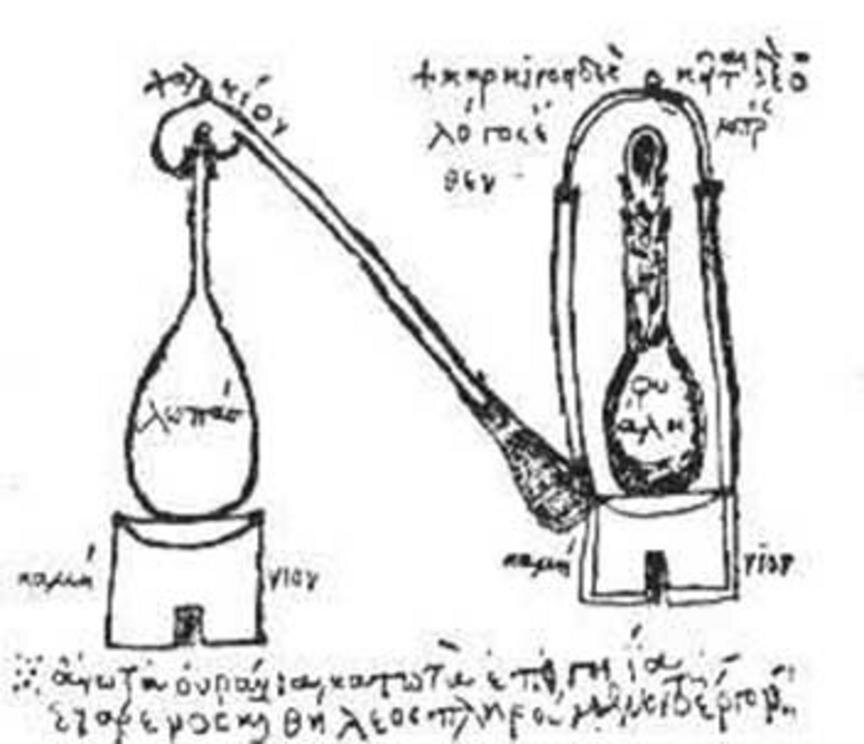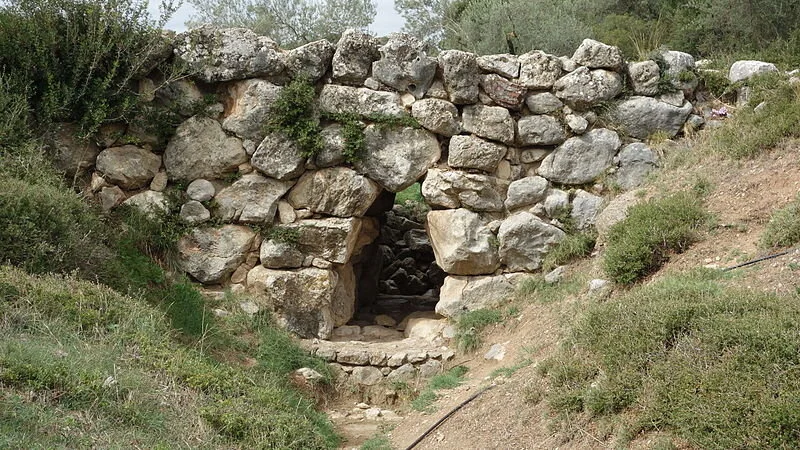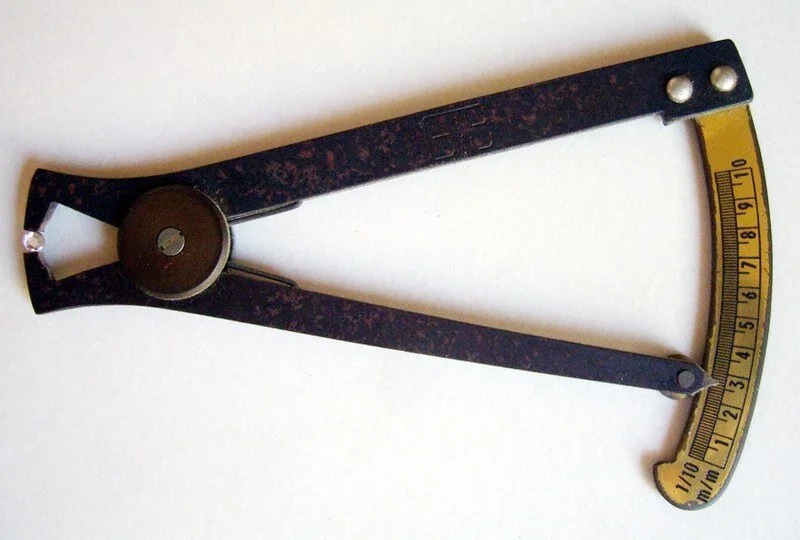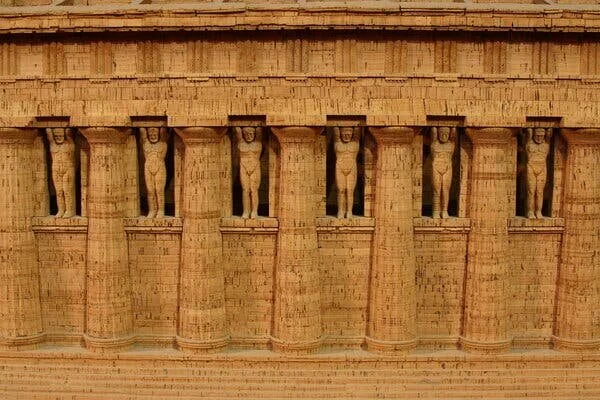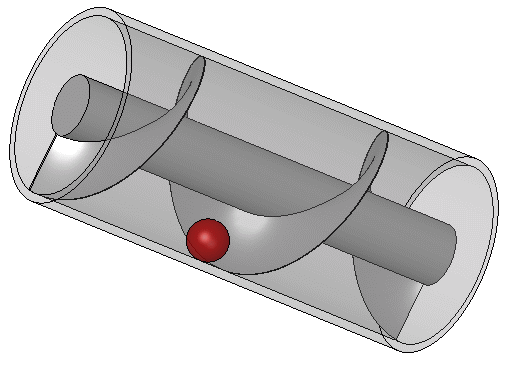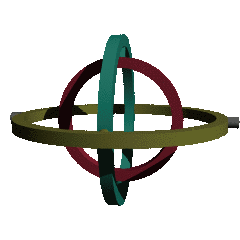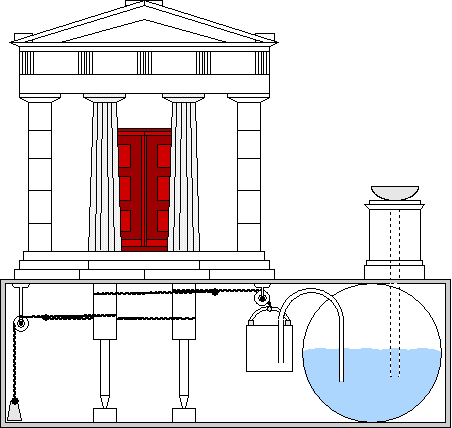This article is a list of major inventions and scientific and mathematical discoveries by Greek people from antiquity through the present day.
Alchemy - c. 1st century BC
Alchemy, a forerunner or Chemistry has its origin in Hellenistic Egypt.
Distillation of spirits by the Greek alchemists in Alexandria in the first century AD
Souvlaki - c. 17th century BC
Excavations in Santorini, Greece, unearthed sets of stone cooking supports used before the 17th century BC. In the supports there are pairs of indentations that were likely used for holding skewers. The line of holes in the base allowed the coals to be supplied with oxygen.
Utilitarian terracotta object, Museum of Cycladic Culture, Akrotiri excavation artifacts, Santorini, Cyclides, Hellas
Arch bridge - c. 1300 BC
Possibly the oldest existing arch bridge is the Mycenaean Arkadiko bridge in Greece from about 1300 BC. The stone corbel arch bridge is still used by the local populace.
Surviving example of Mycenaean bridge construction in Argolis, Peloponnesos
Olympic Games - 776 BC
The ancient Olympic Games were originally a festival of the god Zeus, observed every four years in Olympia by visitors from all over Greece. Later, events such as a footrace, a javelin contest, and wrestling matches were added, evolving into a series of cut-throat athletic competitions among representatives of the various Greek city-states and one of the Panhellenic Games of ancient Greece. The first Olympics is traditionally dated to 776 BC.
Olympia Stadion, 2004
Evidence-based medicine - c. 700 BC
The Greek medical schools at Knidos and Kos were the first to develop rational theories of disease disconnected from religion and superstition and advocate healing based on empirically verified cures.
Physician treating a patient. Red-figure Attic aryballos.
Surgical instruments - c. 700 BC
Ancient medical treatises including the Hippocratic corpus describe surgical tools used for examining injuries, making small incisions, removing arrowheads, gynecological examinations, abortions, tooth extraction, and removing bladder stones.
Surgical tools, 5th century BC, Greece. Reconstruction based on descriptions within the Hippocratic corpus. Thessaloniki Technology Museum
Geography - c. 600 BC
Building on the mapmaking practices of the Near East,[5] the philosopher Anaximander, a student of Thales, was the first known person to produce a scale map of the known world, while some decades later Hecataeus of Miletus was the first to combine map-making with vivid descriptions of the people and landscapes of each location, taken from interviews with sailors and other travellers, initiating a field of study which Eratosthenes later named γεωγραφία (geography).
Possibly what the lost first map of the world by Anaximander looked like.
Railway - c. 600 BC
The 6 to 8.5 km long Diolkos represented a rudimentary form of railway.
Caliper - 6th century BC
Earliest example found in the Giglio wreck near the Italian coast. The wooden piece already featured one fixed and a movable jaw.
Sized 0-10 mm caliper with bow
Theatre - c. 6th century BC
Theatre, in its modern sense, involving the performance of pre-written tragic, dramatic and comedic plays for an audience, first originated in Classical Athens in the 6th century BC.
Epidauros
Truss roof - 550 BC
Crane - c. 515 BC
Labor-saving device that allowed the employment of small and efficient work teams on construction sites. Later winches were added for heavy weights.
Scheme of an ancient Roman Trispastos crane ("Three-pulley-crane"). Being the simplest Roman crane, the Trispastos consisted of a single-beam jib, a winch, a rope, and a block containing three pulleys. Having thus a mechanical advantage of 3:1, a single man working the winch could raise loads of 150 kg (3 pulleys x 50 kg), assuming that 50 kg represent the maximum effort a man can exert over a longer time period.
Democracy - 508 BC
Led by Cleisthenes, Athenians established what is generally held as the first democracy in 508–507 BC. Cleisthenes is referred to as "the father of Athenian democracy."
Pericles' Funeral Oration
Spiral staircase - 480–470 BC
The earliest spiral staircases appear in Temple A in Selinunte, Sicily, to both sides of the cella. The temple was constructed around 480–470 BC.
Temple A in Selinunte. Detail: Remains of spiral stair between pronaos and cella
Winch - 5th century BC
The earliest literary reference to a winch can be found in the account of Herodotus of Halicarnassus on the Persian Wars (Histories 7.36), where he describes how wooden winches were used to tighten the cables for a pontoon bridge across the Hellespont in 480 BC. Winches may have been employed even earlier in Assyria, though. By the 4th century BC, winch and pulley hoists were regarded by Aristotle as common for architectural use (Mech. 18; 853b10-13).
Winch in a sailing boat
Shower - 4th century BC
The Ancient Greeks were the first known people to have showers, which were connected to their lead pipe plumbing system. A shower room for female athletes with plumbed-in water is depicted on an Athenian vase. A whole complex of shower-baths was also found in a 2nd-century BC gymnasium at Pergamum.
Women bathing in a public gymnasium. Gouache painting.
Streets - c. 400 BC
Example: The Porta Rosa (4th–3rd century BC) was the main street of Elea (Italy) and connected the northern quarter to the southern quarter. The street is 5 meters wide. At its steepest, it has an inclination of 18%. It is paved with limestone blocks, grinders cut in square blocks, and on one side a small gutter for the drainage of rain water. The building is dated during the time of the reorganization of the city during Hellenistic age. (4th to 3rd centuries BC)
Greek street - IV-III century BC - Porta Rosa - Velia - Italy The Porta Rosa road was the main street of Elea. It connects the northern quarter with the southern quarter, through the viaduct called Porta Rosa. The street is 5 meters wide and has an incline of 18 % in the steepest part. It is paved with limestone blocks, girders cut in square blocks, and on one side a small gutter for the drainage of rain water. The building is dated during the time of the reorganization of the city during Helenistic age (IV-III century BC)
Catapult - 399 BC
The historian Diodorus Siculus mentions the invention of a mechanical arrow-firing catapult (katapeltikon) by a Greek task force in 399 BC.
Reconstructions of ancient mechanical artillery in the Saalburg Museum, Hesse, Germany
Central heating - c. 350 BC
The Temple of Artemis at Ephesus was warmed by heated air that was circulated through flues laid in the floor, the first known central heating system. Central heating of buildings was later employed throughout the Greek world.
Image from page 85 of "Practical steam and hot water heating and ventilation" (1908)
Lead sheathing - c. 350 BC
To protect a ship's hull from boring creatures.
The Kyrenia ship.
Astrolabe - c. 300 BC
First used around 300 BC by astronomers in Greece. Used to determine the altitude of objects in the sky.
Antikythera mechanism fragment. The mechanism consists of a complex system of 30 wheels and plates with inscriptions relating to signs of the zodiac, months, eclipses and pan-Hellenic games. The study of the fragments suggests that this was a kind of astrolabe.
Canal lock - early 3rd century BC
Built into Ancient Suez Canal under Ptolemy II (283–246 BC).
The opening of the Suez Canal on November 17, 1869 (Credit: The Print Collector/Getty Images)
Ancient Suez Canal - early 3rd century BC
Opened by Greek engineers under Ptolemy II (283–246 BC), following earlier, probably only partly successful attempts.
Canal of the Pharaohs, precursor of the modern Suez Canal.
Escapement - 3rd century BC
Described by the Greek engineer Philo of Byzantium (3rd century BC) in his technical treatise Pneumatics (chapter 31) as part of a washstand automaton for guests washing their hands. Philon's comment that "its construction is similar to that of clocks" indicates that such escapement mechanisms were already integrated in ancient water clocks.
Animation of an anchor escapement used in pendulum clocks.
Archimedes' screw - c. 3rd century BC
This device, capable of lifting solid or liquid substances from a lower plane to a higher elevation, is traditionally attributed to the Greek mathematician Archimedes of Syracuse.
Traditional action of the "Archimedean screw" (invented in Ancient Egypt or Ancient Greece) pumping water up.
Lighthouse - c. 3rd century BC
According to Homeric legend, Palamidis of Nafplio invented the first lighthouse, although they are certainly attested with the Lighthouse of Alexandria (designed and constructed by Sostratus of Cnidus) and the Colossus of Rhodes. However, Themistocles had earlier established a lighthouse at the harbor of Piraeus connected to Athens in the 5th century BC, essentially a small stone column with a fire beacon.
Pharos of Alexandria
Water wheel - 3rd century BC
The earliest evidence of a water-driven wheel is probably the Perachora wheel excavated from Perachora, an inland settlement in the Loutraki-Perachoras municipality of the Corinthia prefecture in the periphery of Peloponnese in Greece. The earliest written reference to a water-driven wheel is in the technical treatises Pneumatica and Parasceuastica of the Greek engineer Philo of Byzantium (Φίλων ὁ Βυζάντιος).
Hydraulic wheel of Perachora
First described by Philo of Byzantium (c. 280–220 BC).
Alarm clock - 3rd century BC
Ctesibius’ water clock, as visualized by the 17th-century French architect Claude Perrault
An invention that society be lost without, the alarm clock’s origins began in ancient Greece in the 3rd century BC. Over time, the alarm clock has undergone a number of changes and improvements from the mechanical alarm to modern gadgets like cell phones, which come with an inbuilt alarm.
The core design of the alarm clock was developed by Hellenistic engineer and inventor Ctesibius (285–222 BC). He managed to fit his clepsydras or water clock with a dial and pointer to indicate the time, and added an elaborate alarm system which involved pebbles dropping on to a gong, or the blowing of a trumpet by forcing bell jars down into water and taking the compressed air through a beating reed at pre-set times.
The ancient Greek philosopher Plato (428–348 BC) was said to possess a large water clock with an unspecified alarm signal similar to the sound of a water organ.
Odometer - c. 3rd century BC
Odometer, a device used in the late Hellenistic time and by Romans for indicating the distance travelled by a vehicle. It was invented sometime in the 3rd century BC. Some historians attribute it to Archimedes, others to Heron of Alexandria. It helped revolutionize the building of roads and travelling by them by accurately measuring distance and being able to carefully illustrate this with a milestone.
Chain drive - 3rd century BC
First described by Philo of Byzantium, the device powered a repeating crossbow, the first known of its kind.
The oldest known illustration of an endless power-transmitting chain drive.
Double-action principle - 3rd century BC
Universal mechanical principle that was discovered and first applied by the engineer Ctesibius in his double action piston pump, which was later developed further by Heron to a fire hose.
Levers - c. 260 BC
First described about 260 BC by the ancient Greek mathematician Archimedes. Although used in prehistoric times, they were first put to practical use for more developed technologies in Ancient Greece.
Archimedes lever, Engraving from Mechanics Magazine, published in London in 1824.
Water mill - c. 250 BC
The use of water power was pioneered by the Greeks: The earliest mention of a water mill in history occurs in Philo's Pneumatics, previously been regarded as a later Arabic interpolation, but according to recent research to be of authentic Greek origin.
Model of a Roman water-powered grain-mill described by Vitruvius.
Three-masted ship (mizzen) - c. 240 BC
First recorded for Syracusia as well as other Syracusan (merchant) ships under Hiero II of Syracuse.
Three-masted training ship Mersey.
Gimbal - 3rd century BC
The inventor Philo of Byzantium (280–220 BC) described an eight-sided ink pot with an opening on each side, which can be turned so that any face is on top, dip in a pen and ink it-yet the ink never runs out through the holes of the side. This was done by the suspension of the inkwell at the center, which was mounted on a series of concentric metal rings which remained stationary no matter which way the pot turns itself.
A Povray-rendered rotating gimbal
Fore-and-aft rig (spritsail) - 2nd century BC
Spritsails, the earliest fore-and-aft rigs, appeared in the 2nd century BC in the Aegean Sea on small Greek craft.
Roman ship with spritsail on the Copenhagen Sarcophagus from the late 3rd century AD. It is one of the oldest depictions of spritsails in the history of navigation.
Air and water pumps - c. 2nd century BC
Ctesibius and various other Greeks of Alexandria of the period developed and put to practical use various air and water pumps which served a variety of purposes, such as a water organ and, by the 1st century AD, Heron's fountain.
Illustration of hydraulic and hydrostatic.
Sakia gear - 2nd century BC
First appeared in 2nd-century BC Hellenistic Egypt, where pictorial evidence already showed it fully developed.
Surveying tools - c. 2nd century BC
Various records relating to mentions of surveying tools have been discovered, mostly in Alexandrian sources, these greatly helped the development of the precision of Roman.
Table of Surveying, 1728 Cyclopaedia.
Analog computers - c. 150 BC
In 1900–1901, the Antikythera mechanism was found in the Antikythera wreck. It is thought that this device was an analog computer designed to calculate astronomical positions and was used to predict lunar and solar eclipses based on Babylonian arithmetic-progression cycles. Whereas the Antikythera mechanism is considered a proper analog computer, the astrolabe (also invented by the Greeks) may be considered as a forerunner.
Antikythera mechanism fragment. The mechanism consists of a complex system of 30 wheels and plates with inscriptions relating to signs of the zodiac, months, eclipses and pan-Hellenic games. The study of the fragments suggests that this was a kind of astrolabe.
Differential gears - c. 100-70 BC
The Antikythera mechanism, from the Roman-era Antikythera wreck, employed a differential gear to determine the angle between the ecliptic positions of the sun and moon, and thus the phase of the moon.
This is an SVG version of the schematic for the Antikythera mechanism.
Fire hose - 1st century BC
Invented by Heron in the basis of Ctesibius' double action piston pump.[32] Allowed for more efficient fire fighting.
Vending machine - 1st century BC
The first vending machine was described by Heron of Alexandria. His machine accepted a coin and then dispensed a fixed amount of holy water. When the coin was deposited, it fell upon a pan attached to a lever. The lever opened up a valve, which let some water flow out. The pan continued to tilt with the weight of the coin until it fell off, at which point a counter-weight would snap the lever back up and turn off the valve.
Wind vane - 50 BC
The Tower of the Winds on the Roman agora in Athens featured atop a wind vane in the form of a bronze Triton holding a rod in his outstretched hand rotating to the wind blowing. Below, its frieze was adorned with the eight wind deities. The 8 m high structure also featured sundials and a water clock inside dates from around 50 BC.
Clock tower - 50 BC
Tower of the Winds, Athens
Steam Engine - 1st century AD
The aeolipile is a simple bladeless radial steam turbine which spins when the central water container is heated. Torque is produced by steam jets exiting the turbine, much like a tip jet. Hero of Alexandria first described the aeolipile in the 1st century AD and many sources give him the credit for its invention.
Hero's aeolipile
Automatic doors - c. 1st century AD
Heron of Alexandria, a 1st-century AD inventor from Alexandria, Egypt, created schematics for automatic doors to be used in a temple with the aid of steam power.
Algebra - c. 2nd century AD
Diophantus was an Alexandrian Greek mathematician and the author of a series of books called Arithmetica. These texts deal with solving algebraic equations, and have led, in number theory to the modern notion of Diophantine equation. In the context where algebra is identified with the theory of equations, Diophantus is credited as its inventor and thus the "father of algebra".
Brain surgery - c. 500 AD
Adelphi University reported that ten sets of skeletal remains, among them six men and four women, all of them believed to be of high social standing, were discovered on the island of Thasos in the North Aegean Sea, with the remains dated back to the Proto-Byzantine period and showing signs of a complex form of brain surgery being performed on one of the individuals.Anagnostis, Agelarakis. "Early evidence of cranial surgical intervention in Abdera, Greece, A nexus to on head wounds of the Hippocratic corpus".
Pointed arch bridge - c. 5th century AD
The earliest known bridge resting on a pointed arch is the 5th or 6th century AD Karamagara Bridge in Cappadocia. Its single arch of 17 m spanned an affluent of the Euphrates. A Greek inscription, citing from the Bible, runs along one side of its arch rib. The structure is today submerged by the Keban Reservoir.
Karamagara Bridge
Greek fire - c. 672 AD
Greek fire was an incendiary weapon used by the Eastern Roman (Byzantine) Empire that was first developed c. 672. The Byzantines typically used it in naval battles to great effect, as it could continue burning while floating on water.
Image from an illuminated manuscript, the Madrid Skylitzes, showing Greek fire in use against the fleet of the rebel.
Flamethrower - 7th century AD
Greek fire, heated in a brazier and pressurized by means of a pump, was ejected by an operator through a siphon in any direction against the enemy. Alternatively, it could be poured down from swivel cranes or hurled in pottery grenades.
Use of a hand-siphon, a portable flame-thrower, from a siege tower. Detail from the medieval manuscript Codex Vaticanus Graecus 1605.
Grenades - 8th century AD
Grenades appeared not long after the reign of Leo III (717–741), when Byzantine soldiers learned that Greek fire could not only be projected by flamethrowers, but also be thrown in stone and ceramic jars. Larger containers were hurled by catapults or trebuchets at the enemy, either ignited before release or set alight by fire arrows after impact. Grenades were later adopted for use by Muslim armies: Vessels of the characteristic spheroconical shape which many authors identify as grenade shells were found over much of the Islamic world.
Grenades that were filled with liquid fire (Υγρό Πυρ) and caltrops from the fortress of Chania (Χανιά) 10th and 12th century. National Historical Museum, Athens, Greece.
Optical telegraph - c. 840 AD
In the 9th century, during the Arab–Byzantine wars, the Byzantine Empire used a system of beacons to transmit messages from the border with the Abbasid Caliphate across Asia Minor to the Byzantine capital, Constantinople.The main line of beacons stretched over some 450 miles (720 km). In the open spaces of central Asia Minor, the stations were placed over 60 miles (97 km) apart, while in Bithynia, with its more broken terrain, the intervals were reduced to ca. 35 miles (56 km). Based on modern experiments, a message could be transmitted the entire length of the line within an hour. The system was reportedly devised in the reign of Emperor Theophilos (ruled 829–842) by Leo the Mathematician, and functioned through two identical water clocks placed at the two terminal stations, Loulon and the Lighthouse. Different messages were assigned to each of twelve hours, so that the lighting of a bonfire on the first beacon on a particular hour signalled a specific event and was transmitted down the line to Constantinople.
The line of beacons across Asia Minor connecting the Arab-Byzantine border at the Cilician Gates with the Byzantine capital of Constantinople in the 9th century.
Hand trebuchet - 965 AD
The hand-trebuchet (cheiromangana) was a staff sling mounted on a pole using a lever mechanism to propel projectiles. Basically a portable trebuchet which could be operated by a single man, it was advocated by emperor Nikephoros II Phokas around 965 to disrupt enemy formations in the open field. It was also mentioned in the Taktika of general Nikephoros Ouranos (ca. 1000), and listed in the Anonymus De obsidione toleranda as a form of artillery.
Early 12th-century Sicilian-Byzantine depiction of a traction trebuchet.
Feta - c. 10th century
Feta cheese, specifically, is first recorded in the Byzantine Empire in Avicenna's Poem on Medicine under the name prósphatos (Greek: πρόσφατος, "recent" or "fresh"), and was produced by the Cretans and the Vlachs of Thessaly.
Feta Cheese
Counterweight Trebuchet - 12th century AD
The earliest written record of the counterweight trebuchet, a vastly more powerful design than the simple traction trebuchet, appears in the work of the 12th-century historian Niketas Choniates. Niketas describes a stone projector used by future emperor Andronikos I Komnenos at the siege of Zevgminon in 1165. This was equipped with a windlass, an apparatus required neither for the traction nor hybrid trebuchet to launch missiles.
Trebuchet at Château des Baux, France (reconstruction).
Tsipouro - c. 14th century
The first production of tsipouro was the work of Greek Orthodox monks in the 14th century on Mount Athos in Macedonia, Greece.
Tsipouro from Thessaly.
Metaxa - 1888
Metaxa is a Greek spirit invented by Spyros Metaxas in 1888. It is exported to over 65 countries and it is among the 100 strongest spirit brands worldwide.
Metaxa 12 stars bottle: Smoothness Defined.
Pap smear - 1923
A test for cervical cancer developed by the Greek physician George Papanikolaou in 1923.
Micrograph showing a high-grade squamous intraepithelial lesion (HSIL).
Frappé coffee - 1957
The Greek version of café frappé, using instant coffee, was invented in 1957 at the Thessaloniki International Fair.
"Frappe" Greek Iced coffee.
Mini - 1959
This distinctive two-door car was designed for the British Motor Corporation by Greek engineer Sir Alec Issigonis. His grandfather Demosthenis migrated to Smyrna from Paros in Greece in the 1830s and through the work he did for the British-built Smyrna-Aydın Railway.
Alec Issigonis photographed at Austin, Longbridge standing next to the first Mini (621AOK) and a new 1965 Morris Mini Minor Deluxe.
Caller ID - 1968
In 1968, Theodore Paraskevakos, while working in as a communications engineer for SITA in Athens, Greece, began developing a system to automatically identify a telephone caller to a call recipient. Developing the method for the basis for modern-day Caller ID technology.
Original Caller Identification receiver installed at Boeing/PEC facility in Huntsville Alabama.
Libor - 1969
The London Inter-bank Offered Rate interest rate benchmark was devised by Greek banker Minos Zombanakis.
The City of London
BlackBerry - 1996
Greek-Canadian businessman Mike Lazaridis founded BlackBerry, which created and manufactures the BlackBerry wireless handheld device. Lazaridis served in various positions including Co-Chairman and Co-CEO of BlackBerry from 1984 to 2012 and Board Vice Chair and Chair of the Innovation Committee from 2012 to 2013.
BlackBerry 8820, BlackBerry Bold 9900 and BlackBerry Classic for comparison.
Mathematics
Mathematical deduction – Thales of Miletus, considered by Aristotle to be the first Greek philosopher,[74] is thought to be the first individual to apply deductive reasoning to produce mathematical proofs, particularly in the field of geometry.
Thales' theorem – One of the most basic theorems of geometry, stating that whenever an angle is drawn from two ends of the diameter of a circle to any third point on its circumference, the angle formed at the third point is always a perfect right angle. The phenomenon was known empirically to the Indians and Babylonians but was first proved in the 6th century BC by Thales of Miletus, making him the first known individual to whom a mathematical discovery has been attributed.
Intercept theorem – Also attributed to Thales is the fundamental theorem of geometry that states that the ratios of corresponding sides of similar triangles (i.e. triangles formed from the intersection of two common lines with two different parallel lines) are equal. Thales is said to have used his theorem to determine the height of pyramids by measuring the lengths of their shadows.
Conic sections – First developed by Menaechmus in the 4th century BC, but the most significant contribution is by Apollonius of Perga in the 3rd century BC.
Method of exhaustion – Formalized by Eudoxus of Cnidus in the early 4th century BC, used by Archimedes to calculate the value of Pi and the area under a curve.
Mathematical proof – The mathematical proof was a product of Greek mathematics, evolving gradually to reach the method still used today in Euclid's Elements around 300 BC.
Sieve of Eratosthenes – Developed by Eratosthenes in the 3rd century BC to calculate prime numbers.
Natural sciences
Circumference of the Earth – The circumference of the Earth was first calculated by Eratosthenes of Cyrene in 240 BC, with an error of 1% to 15% (depending on the definition of a stadion).
Heliocentrism – The notion that the Earth and planets revolves around the Sun was first proposed by Aristarchus of Samos in the 3rd century BC.
Spherical Earth – The concept of a spherical Earth first appears in the writings of the Pythagoreans around the 6th century BC.
Source: wikipedia

